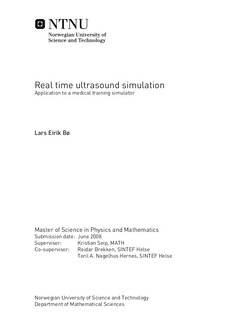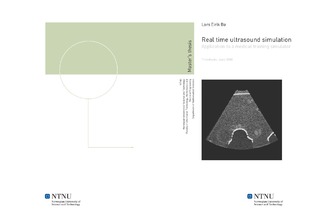| dc.contributor.advisor | Seip, Kristian | nb_NO |
| dc.contributor.advisor | Brekken, Reidar | nb_NO |
| dc.contributor.advisor | Nagelhus Hernes, Toril A. | nb_NO |
| dc.contributor.author | Bø, Lars Eirik | nb_NO |
| dc.date.accessioned | 2014-12-19T14:00:08Z | |
| dc.date.available | 2014-12-19T14:00:08Z | |
| dc.date.created | 2013-06-20 | nb_NO |
| dc.date.issued | 2008 | nb_NO |
| dc.identifier | 631283 | nb_NO |
| dc.identifier | ntnudaim:4254 | nb_NO |
| dc.identifier.uri | http://hdl.handle.net/11250/259156 | |
| dc.description.abstract | As ultrasound technology today finds new applications and becomes available to more and more users, the demand for good training procedures and material increases. This has motivated a research project aimed at developing an ultrasound simulator for training purposes. As a part of the project, a simulation method has previously been developed capable of producing artificial ultrasound images in real time based on three-dimensional CT data. However, the method takes advantage mainly of the qualitative, visual similarities between CT and ultrasound images. This master's project investigates the possibility of exploiting the quantitative information available in the CT data in combination with physical models of ultrasound imaging. The aim is to enhance the realism of the simulations while still retaining its real time performance. As a part of the investigations, a new simulation method has been implemented in MATLAB. The method estimates acoustic impedance values from CT numbers, and combines this with physical models connecting the estimates to effects fundamental to ultrasound image formation, mainly reflection and scattering. Effects such as absorption and electronic noise are also added to the simulation. Comparison between simulated images and corresponding true ultrasound images shows that reflections and shadows are quite well reproduced by the new method. The simulated artifacts are also slightly more realistic than those produced by the previous method, indicating that such computations can benefit from taking quantitative information into account. The attempt at computing the scattering of ultrasound, on the other hand, is not successful. It is likely that the information contained in the CT images is insufficient to predict such effects. Alternative methods should therefore be considered for this purpose. | nb_NO |
| dc.language | eng | nb_NO |
| dc.publisher | Institutt for matematiske fag | nb_NO |
| dc.title | Real time ultrasound simulation: Application to a medical training simulator | nb_NO |
| dc.type | Master thesis | nb_NO |
| dc.source.pagenumber | 55 | nb_NO |
| dc.contributor.department | Norges teknisk-naturvitenskapelige universitet, Fakultet for informasjonsteknologi, matematikk og elektroteknikk, Institutt for matematiske fag | nb_NO |

